Report on UK Taxation: Tax Environment, Obligations, and Calculations
VerifiedAdded on 2020/02/03
|17
|4968
|303
Report
AI Summary
This report provides a detailed analysis of the UK taxation system. It begins with an introduction to the UK tax environment, outlining the roles and responsibilities of tax practitioners and the tax obligations of both taxpayers and agents, including the implications of non-compliance. The report then delves into practical calculations, including the determination of relevant income, expenses, and allowances for employed and self-employed individuals, along with the calculation of their respective tax liabilities and payment dates. Furthermore, it covers the completion of relevant documentation and tax returns. The report also includes the calculation of chargeable profits, tax liabilities, and income tax deductions, as well as the identification of chargeable assets, the calculation of capital gains and losses, and the determination of capital gains tax payable. The report provides a comprehensive overview of the UK tax system and its practical applications.
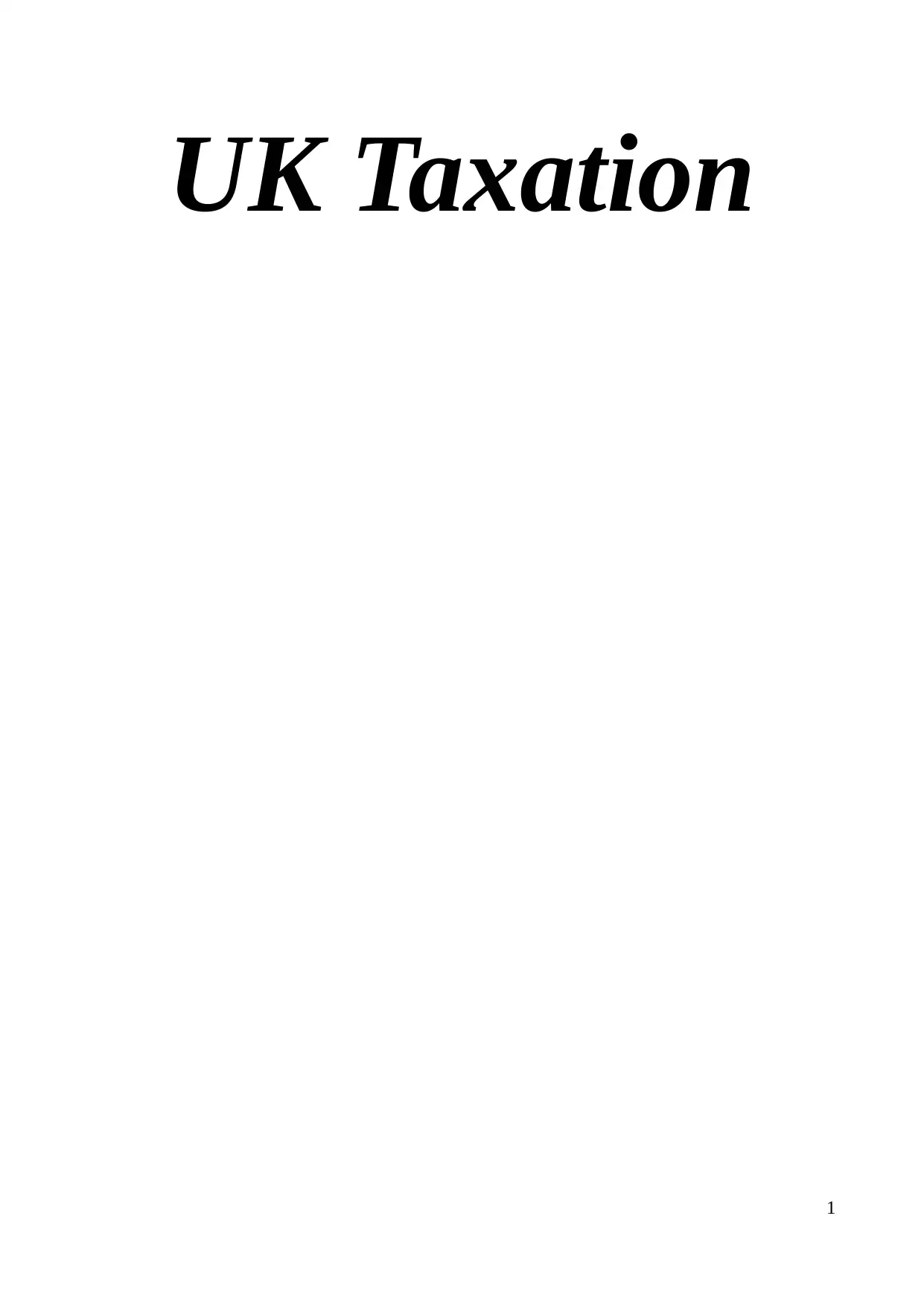
UK Taxation
1
1
Paraphrase This Document
Need a fresh take? Get an instant paraphrase of this document with our AI Paraphraser
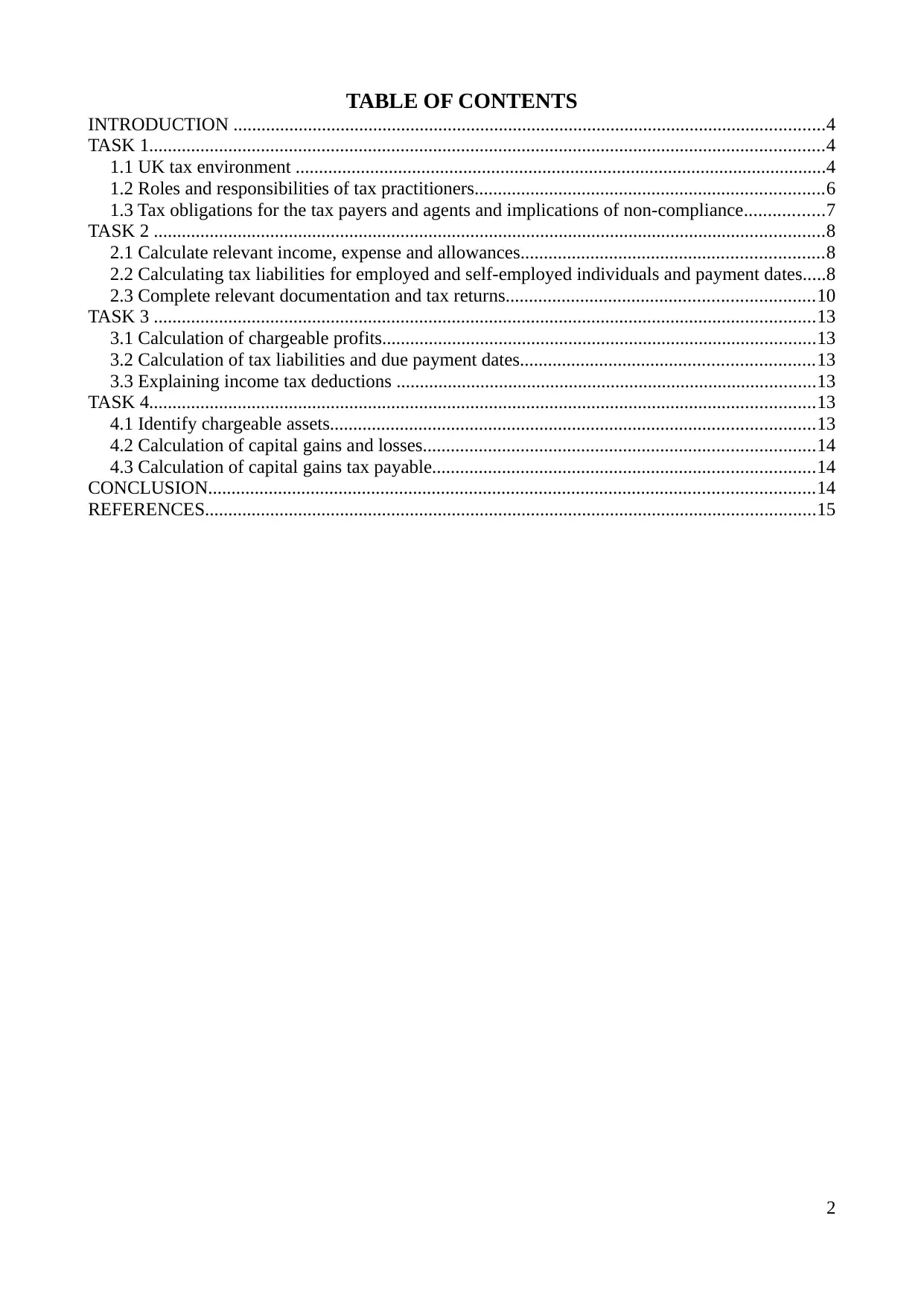
TABLE OF CONTENTS
INTRODUCTION ...............................................................................................................................4
TASK 1.................................................................................................................................................4
1.1 UK tax environment ..................................................................................................................4
1.2 Roles and responsibilities of tax practitioners...........................................................................6
1.3 Tax obligations for the tax payers and agents and implications of non-compliance.................7
TASK 2 ................................................................................................................................................8
2.1 Calculate relevant income, expense and allowances.................................................................8
2.2 Calculating tax liabilities for employed and self-employed individuals and payment dates.....8
2.3 Complete relevant documentation and tax returns..................................................................10
TASK 3 ..............................................................................................................................................13
3.1 Calculation of chargeable profits.............................................................................................13
3.2 Calculation of tax liabilities and due payment dates...............................................................13
3.3 Explaining income tax deductions ..........................................................................................13
TASK 4...............................................................................................................................................13
4.1 Identify chargeable assets........................................................................................................13
4.2 Calculation of capital gains and losses....................................................................................14
4.3 Calculation of capital gains tax payable..................................................................................14
CONCLUSION..................................................................................................................................14
REFERENCES...................................................................................................................................15
2
INTRODUCTION ...............................................................................................................................4
TASK 1.................................................................................................................................................4
1.1 UK tax environment ..................................................................................................................4
1.2 Roles and responsibilities of tax practitioners...........................................................................6
1.3 Tax obligations for the tax payers and agents and implications of non-compliance.................7
TASK 2 ................................................................................................................................................8
2.1 Calculate relevant income, expense and allowances.................................................................8
2.2 Calculating tax liabilities for employed and self-employed individuals and payment dates.....8
2.3 Complete relevant documentation and tax returns..................................................................10
TASK 3 ..............................................................................................................................................13
3.1 Calculation of chargeable profits.............................................................................................13
3.2 Calculation of tax liabilities and due payment dates...............................................................13
3.3 Explaining income tax deductions ..........................................................................................13
TASK 4...............................................................................................................................................13
4.1 Identify chargeable assets........................................................................................................13
4.2 Calculation of capital gains and losses....................................................................................14
4.3 Calculation of capital gains tax payable..................................................................................14
CONCLUSION..................................................................................................................................14
REFERENCES...................................................................................................................................15
2
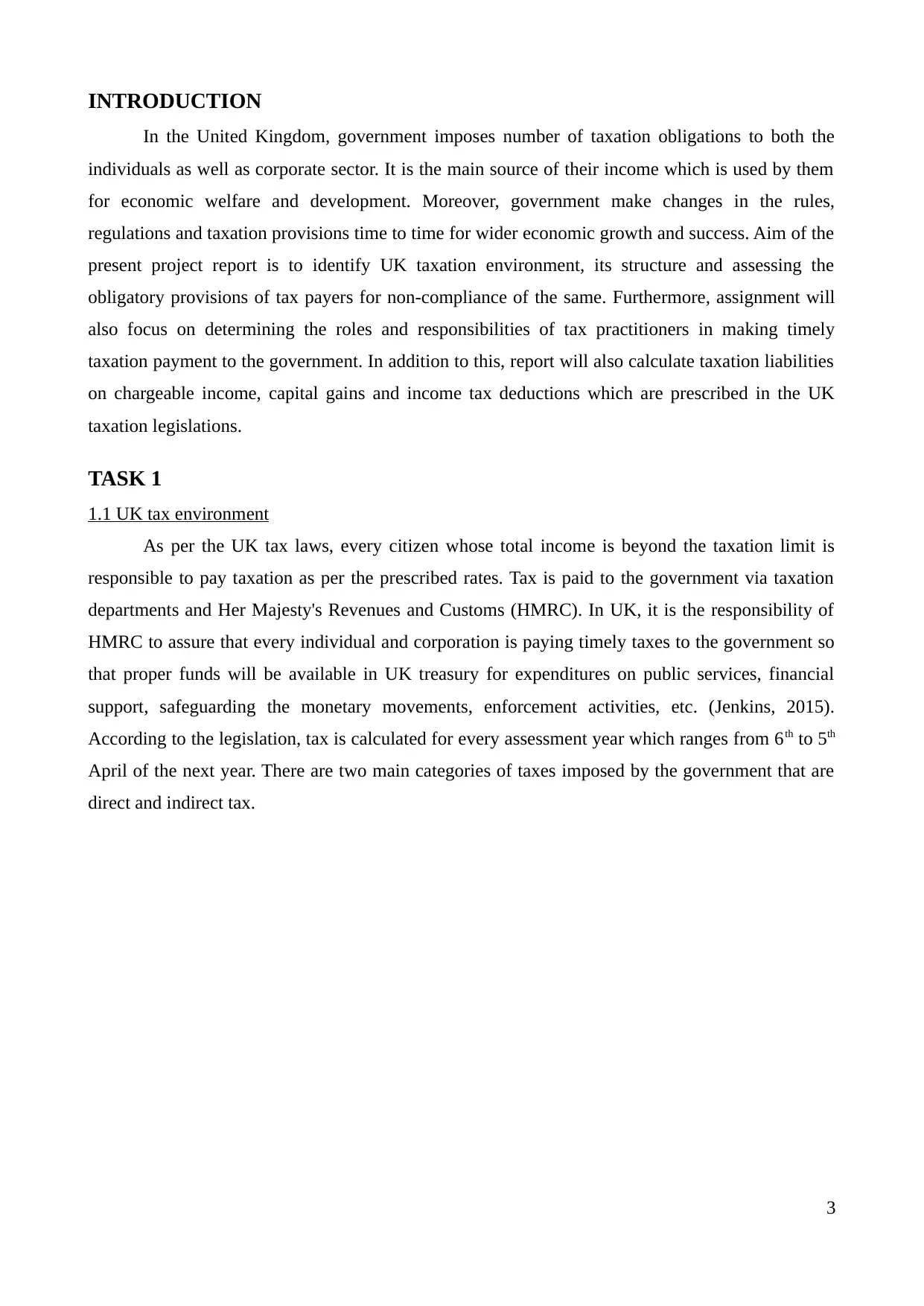
INTRODUCTION
In the United Kingdom, government imposes number of taxation obligations to both the
individuals as well as corporate sector. It is the main source of their income which is used by them
for economic welfare and development. Moreover, government make changes in the rules,
regulations and taxation provisions time to time for wider economic growth and success. Aim of the
present project report is to identify UK taxation environment, its structure and assessing the
obligatory provisions of tax payers for non-compliance of the same. Furthermore, assignment will
also focus on determining the roles and responsibilities of tax practitioners in making timely
taxation payment to the government. In addition to this, report will also calculate taxation liabilities
on chargeable income, capital gains and income tax deductions which are prescribed in the UK
taxation legislations.
TASK 1
1.1 UK tax environment
As per the UK tax laws, every citizen whose total income is beyond the taxation limit is
responsible to pay taxation as per the prescribed rates. Tax is paid to the government via taxation
departments and Her Majesty's Revenues and Customs (HMRC). In UK, it is the responsibility of
HMRC to assure that every individual and corporation is paying timely taxes to the government so
that proper funds will be available in UK treasury for expenditures on public services, financial
support, safeguarding the monetary movements, enforcement activities, etc. (Jenkins, 2015).
According to the legislation, tax is calculated for every assessment year which ranges from 6th to 5th
April of the next year. There are two main categories of taxes imposed by the government that are
direct and indirect tax.
3
In the United Kingdom, government imposes number of taxation obligations to both the
individuals as well as corporate sector. It is the main source of their income which is used by them
for economic welfare and development. Moreover, government make changes in the rules,
regulations and taxation provisions time to time for wider economic growth and success. Aim of the
present project report is to identify UK taxation environment, its structure and assessing the
obligatory provisions of tax payers for non-compliance of the same. Furthermore, assignment will
also focus on determining the roles and responsibilities of tax practitioners in making timely
taxation payment to the government. In addition to this, report will also calculate taxation liabilities
on chargeable income, capital gains and income tax deductions which are prescribed in the UK
taxation legislations.
TASK 1
1.1 UK tax environment
As per the UK tax laws, every citizen whose total income is beyond the taxation limit is
responsible to pay taxation as per the prescribed rates. Tax is paid to the government via taxation
departments and Her Majesty's Revenues and Customs (HMRC). In UK, it is the responsibility of
HMRC to assure that every individual and corporation is paying timely taxes to the government so
that proper funds will be available in UK treasury for expenditures on public services, financial
support, safeguarding the monetary movements, enforcement activities, etc. (Jenkins, 2015).
According to the legislation, tax is calculated for every assessment year which ranges from 6th to 5th
April of the next year. There are two main categories of taxes imposed by the government that are
direct and indirect tax.
3
⊘ This is a preview!⊘
Do you want full access?
Subscribe today to unlock all pages.

Trusted by 1+ million students worldwide
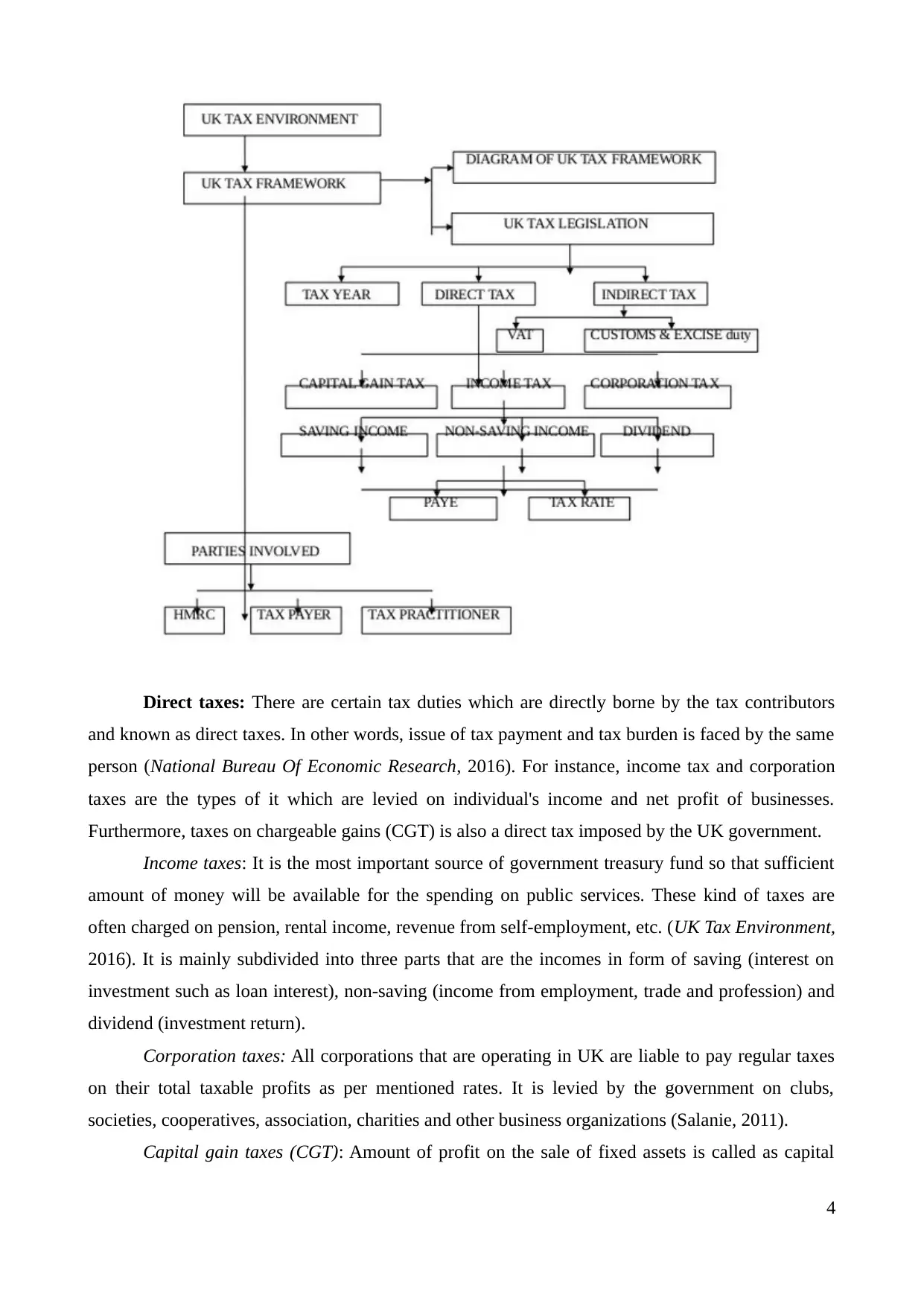
Direct taxes: There are certain tax duties which are directly borne by the tax contributors
and known as direct taxes. In other words, issue of tax payment and tax burden is faced by the same
person (National Bureau Of Economic Research, 2016). For instance, income tax and corporation
taxes are the types of it which are levied on individual's income and net profit of businesses.
Furthermore, taxes on chargeable gains (CGT) is also a direct tax imposed by the UK government.
Income taxes: It is the most important source of government treasury fund so that sufficient
amount of money will be available for the spending on public services. These kind of taxes are
often charged on pension, rental income, revenue from self-employment, etc. (UK Tax Environment,
2016). It is mainly subdivided into three parts that are the incomes in form of saving (interest on
investment such as loan interest), non-saving (income from employment, trade and profession) and
dividend (investment return).
Corporation taxes: All corporations that are operating in UK are liable to pay regular taxes
on their total taxable profits as per mentioned rates. It is levied by the government on clubs,
societies, cooperatives, association, charities and other business organizations (Salanie, 2011).
Capital gain taxes (CGT): Amount of profit on the sale of fixed assets is called as capital
4
and known as direct taxes. In other words, issue of tax payment and tax burden is faced by the same
person (National Bureau Of Economic Research, 2016). For instance, income tax and corporation
taxes are the types of it which are levied on individual's income and net profit of businesses.
Furthermore, taxes on chargeable gains (CGT) is also a direct tax imposed by the UK government.
Income taxes: It is the most important source of government treasury fund so that sufficient
amount of money will be available for the spending on public services. These kind of taxes are
often charged on pension, rental income, revenue from self-employment, etc. (UK Tax Environment,
2016). It is mainly subdivided into three parts that are the incomes in form of saving (interest on
investment such as loan interest), non-saving (income from employment, trade and profession) and
dividend (investment return).
Corporation taxes: All corporations that are operating in UK are liable to pay regular taxes
on their total taxable profits as per mentioned rates. It is levied by the government on clubs,
societies, cooperatives, association, charities and other business organizations (Salanie, 2011).
Capital gain taxes (CGT): Amount of profit on the sale of fixed assets is called as capital
4
Paraphrase This Document
Need a fresh take? Get an instant paraphrase of this document with our AI Paraphraser
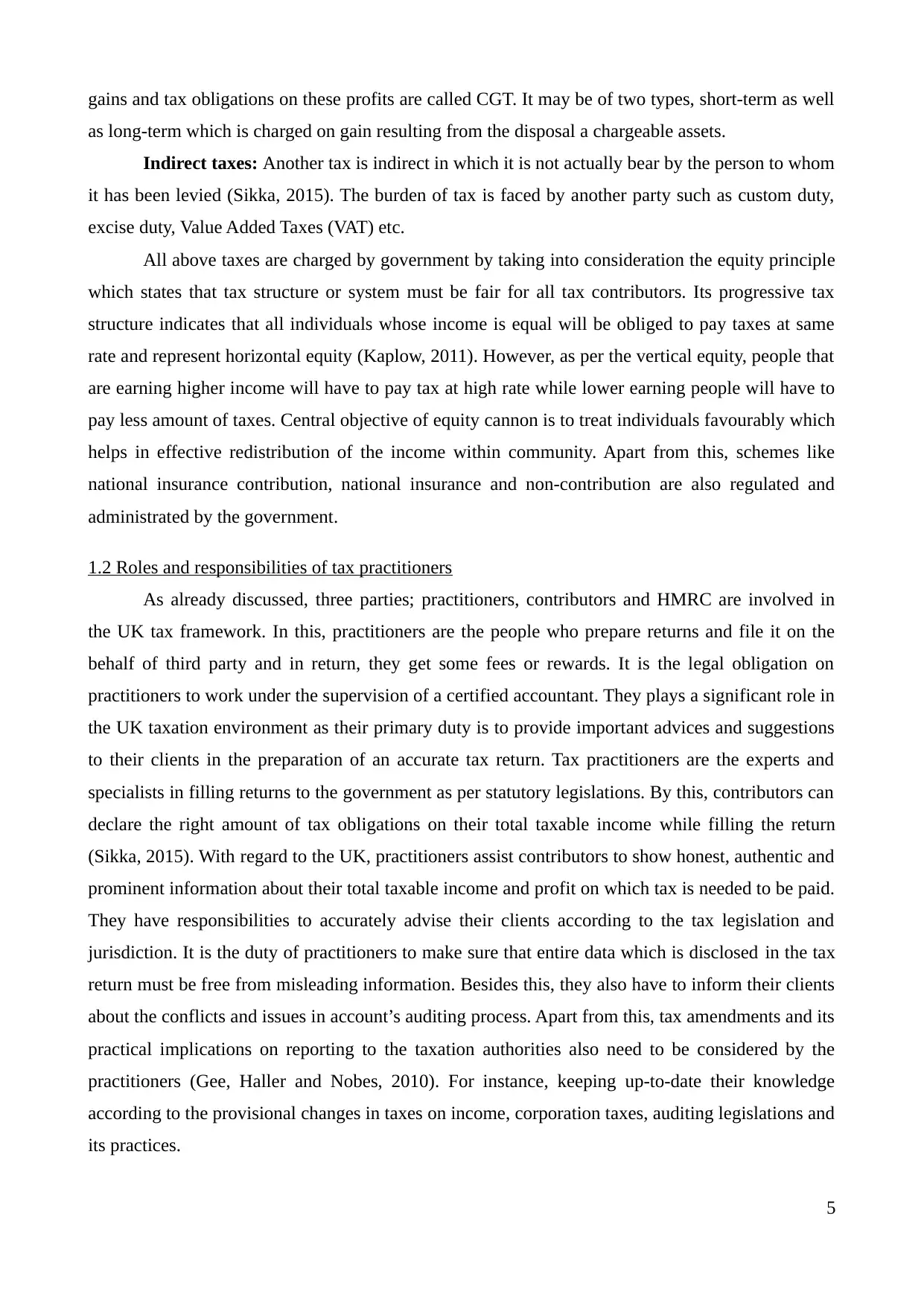
gains and tax obligations on these profits are called CGT. It may be of two types, short-term as well
as long-term which is charged on gain resulting from the disposal a chargeable assets.
Indirect taxes: Another tax is indirect in which it is not actually bear by the person to whom
it has been levied (Sikka, 2015). The burden of tax is faced by another party such as custom duty,
excise duty, Value Added Taxes (VAT) etc.
All above taxes are charged by government by taking into consideration the equity principle
which states that tax structure or system must be fair for all tax contributors. Its progressive tax
structure indicates that all individuals whose income is equal will be obliged to pay taxes at same
rate and represent horizontal equity (Kaplow, 2011). However, as per the vertical equity, people that
are earning higher income will have to pay tax at high rate while lower earning people will have to
pay less amount of taxes. Central objective of equity cannon is to treat individuals favourably which
helps in effective redistribution of the income within community. Apart from this, schemes like
national insurance contribution, national insurance and non-contribution are also regulated and
administrated by the government.
1.2 Roles and responsibilities of tax practitioners
As already discussed, three parties; practitioners, contributors and HMRC are involved in
the UK tax framework. In this, practitioners are the people who prepare returns and file it on the
behalf of third party and in return, they get some fees or rewards. It is the legal obligation on
practitioners to work under the supervision of a certified accountant. They plays a significant role in
the UK taxation environment as their primary duty is to provide important advices and suggestions
to their clients in the preparation of an accurate tax return. Tax practitioners are the experts and
specialists in filling returns to the government as per statutory legislations. By this, contributors can
declare the right amount of tax obligations on their total taxable income while filling the return
(Sikka, 2015). With regard to the UK, practitioners assist contributors to show honest, authentic and
prominent information about their total taxable income and profit on which tax is needed to be paid.
They have responsibilities to accurately advise their clients according to the tax legislation and
jurisdiction. It is the duty of practitioners to make sure that entire data which is disclosed in the tax
return must be free from misleading information. Besides this, they also have to inform their clients
about the conflicts and issues in account’s auditing process. Apart from this, tax amendments and its
practical implications on reporting to the taxation authorities also need to be considered by the
practitioners (Gee, Haller and Nobes, 2010). For instance, keeping up-to-date their knowledge
according to the provisional changes in taxes on income, corporation taxes, auditing legislations and
its practices.
5
as long-term which is charged on gain resulting from the disposal a chargeable assets.
Indirect taxes: Another tax is indirect in which it is not actually bear by the person to whom
it has been levied (Sikka, 2015). The burden of tax is faced by another party such as custom duty,
excise duty, Value Added Taxes (VAT) etc.
All above taxes are charged by government by taking into consideration the equity principle
which states that tax structure or system must be fair for all tax contributors. Its progressive tax
structure indicates that all individuals whose income is equal will be obliged to pay taxes at same
rate and represent horizontal equity (Kaplow, 2011). However, as per the vertical equity, people that
are earning higher income will have to pay tax at high rate while lower earning people will have to
pay less amount of taxes. Central objective of equity cannon is to treat individuals favourably which
helps in effective redistribution of the income within community. Apart from this, schemes like
national insurance contribution, national insurance and non-contribution are also regulated and
administrated by the government.
1.2 Roles and responsibilities of tax practitioners
As already discussed, three parties; practitioners, contributors and HMRC are involved in
the UK tax framework. In this, practitioners are the people who prepare returns and file it on the
behalf of third party and in return, they get some fees or rewards. It is the legal obligation on
practitioners to work under the supervision of a certified accountant. They plays a significant role in
the UK taxation environment as their primary duty is to provide important advices and suggestions
to their clients in the preparation of an accurate tax return. Tax practitioners are the experts and
specialists in filling returns to the government as per statutory legislations. By this, contributors can
declare the right amount of tax obligations on their total taxable income while filling the return
(Sikka, 2015). With regard to the UK, practitioners assist contributors to show honest, authentic and
prominent information about their total taxable income and profit on which tax is needed to be paid.
They have responsibilities to accurately advise their clients according to the tax legislation and
jurisdiction. It is the duty of practitioners to make sure that entire data which is disclosed in the tax
return must be free from misleading information. Besides this, they also have to inform their clients
about the conflicts and issues in account’s auditing process. Apart from this, tax amendments and its
practical implications on reporting to the taxation authorities also need to be considered by the
practitioners (Gee, Haller and Nobes, 2010). For instance, keeping up-to-date their knowledge
according to the provisional changes in taxes on income, corporation taxes, auditing legislations and
its practices.
5
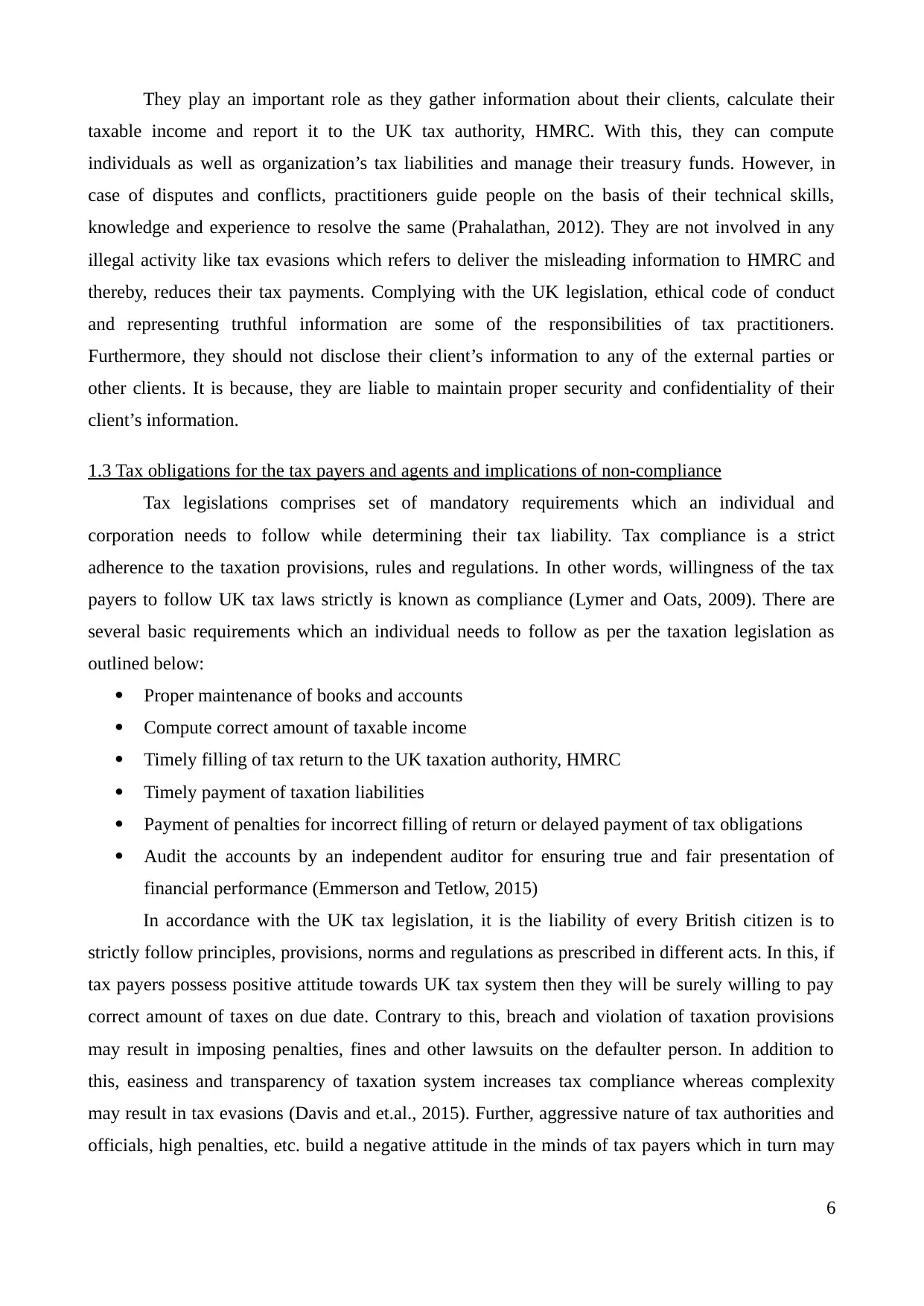
They play an important role as they gather information about their clients, calculate their
taxable income and report it to the UK tax authority, HMRC. With this, they can compute
individuals as well as organization’s tax liabilities and manage their treasury funds. However, in
case of disputes and conflicts, practitioners guide people on the basis of their technical skills,
knowledge and experience to resolve the same (Prahalathan, 2012). They are not involved in any
illegal activity like tax evasions which refers to deliver the misleading information to HMRC and
thereby, reduces their tax payments. Complying with the UK legislation, ethical code of conduct
and representing truthful information are some of the responsibilities of tax practitioners.
Furthermore, they should not disclose their client’s information to any of the external parties or
other clients. It is because, they are liable to maintain proper security and confidentiality of their
client’s information.
1.3 Tax obligations for the tax payers and agents and implications of non-compliance
Tax legislations comprises set of mandatory requirements which an individual and
corporation needs to follow while determining their tax liability. Tax compliance is a strict
adherence to the taxation provisions, rules and regulations. In other words, willingness of the tax
payers to follow UK tax laws strictly is known as compliance (Lymer and Oats, 2009). There are
several basic requirements which an individual needs to follow as per the taxation legislation as
outlined below:
Proper maintenance of books and accounts
Compute correct amount of taxable income
Timely filling of tax return to the UK taxation authority, HMRC
Timely payment of taxation liabilities
Payment of penalties for incorrect filling of return or delayed payment of tax obligations
Audit the accounts by an independent auditor for ensuring true and fair presentation of
financial performance (Emmerson and Tetlow, 2015)
In accordance with the UK tax legislation, it is the liability of every British citizen is to
strictly follow principles, provisions, norms and regulations as prescribed in different acts. In this, if
tax payers possess positive attitude towards UK tax system then they will be surely willing to pay
correct amount of taxes on due date. Contrary to this, breach and violation of taxation provisions
may result in imposing penalties, fines and other lawsuits on the defaulter person. In addition to
this, easiness and transparency of taxation system increases tax compliance whereas complexity
may result in tax evasions (Davis and et.al., 2015). Further, aggressive nature of tax authorities and
officials, high penalties, etc. build a negative attitude in the minds of tax payers which in turn may
6
taxable income and report it to the UK tax authority, HMRC. With this, they can compute
individuals as well as organization’s tax liabilities and manage their treasury funds. However, in
case of disputes and conflicts, practitioners guide people on the basis of their technical skills,
knowledge and experience to resolve the same (Prahalathan, 2012). They are not involved in any
illegal activity like tax evasions which refers to deliver the misleading information to HMRC and
thereby, reduces their tax payments. Complying with the UK legislation, ethical code of conduct
and representing truthful information are some of the responsibilities of tax practitioners.
Furthermore, they should not disclose their client’s information to any of the external parties or
other clients. It is because, they are liable to maintain proper security and confidentiality of their
client’s information.
1.3 Tax obligations for the tax payers and agents and implications of non-compliance
Tax legislations comprises set of mandatory requirements which an individual and
corporation needs to follow while determining their tax liability. Tax compliance is a strict
adherence to the taxation provisions, rules and regulations. In other words, willingness of the tax
payers to follow UK tax laws strictly is known as compliance (Lymer and Oats, 2009). There are
several basic requirements which an individual needs to follow as per the taxation legislation as
outlined below:
Proper maintenance of books and accounts
Compute correct amount of taxable income
Timely filling of tax return to the UK taxation authority, HMRC
Timely payment of taxation liabilities
Payment of penalties for incorrect filling of return or delayed payment of tax obligations
Audit the accounts by an independent auditor for ensuring true and fair presentation of
financial performance (Emmerson and Tetlow, 2015)
In accordance with the UK tax legislation, it is the liability of every British citizen is to
strictly follow principles, provisions, norms and regulations as prescribed in different acts. In this, if
tax payers possess positive attitude towards UK tax system then they will be surely willing to pay
correct amount of taxes on due date. Contrary to this, breach and violation of taxation provisions
may result in imposing penalties, fines and other lawsuits on the defaulter person. In addition to
this, easiness and transparency of taxation system increases tax compliance whereas complexity
may result in tax evasions (Davis and et.al., 2015). Further, aggressive nature of tax authorities and
officials, high penalties, etc. build a negative attitude in the minds of tax payers which in turn may
6
⊘ This is a preview!⊘
Do you want full access?
Subscribe today to unlock all pages.

Trusted by 1+ million students worldwide
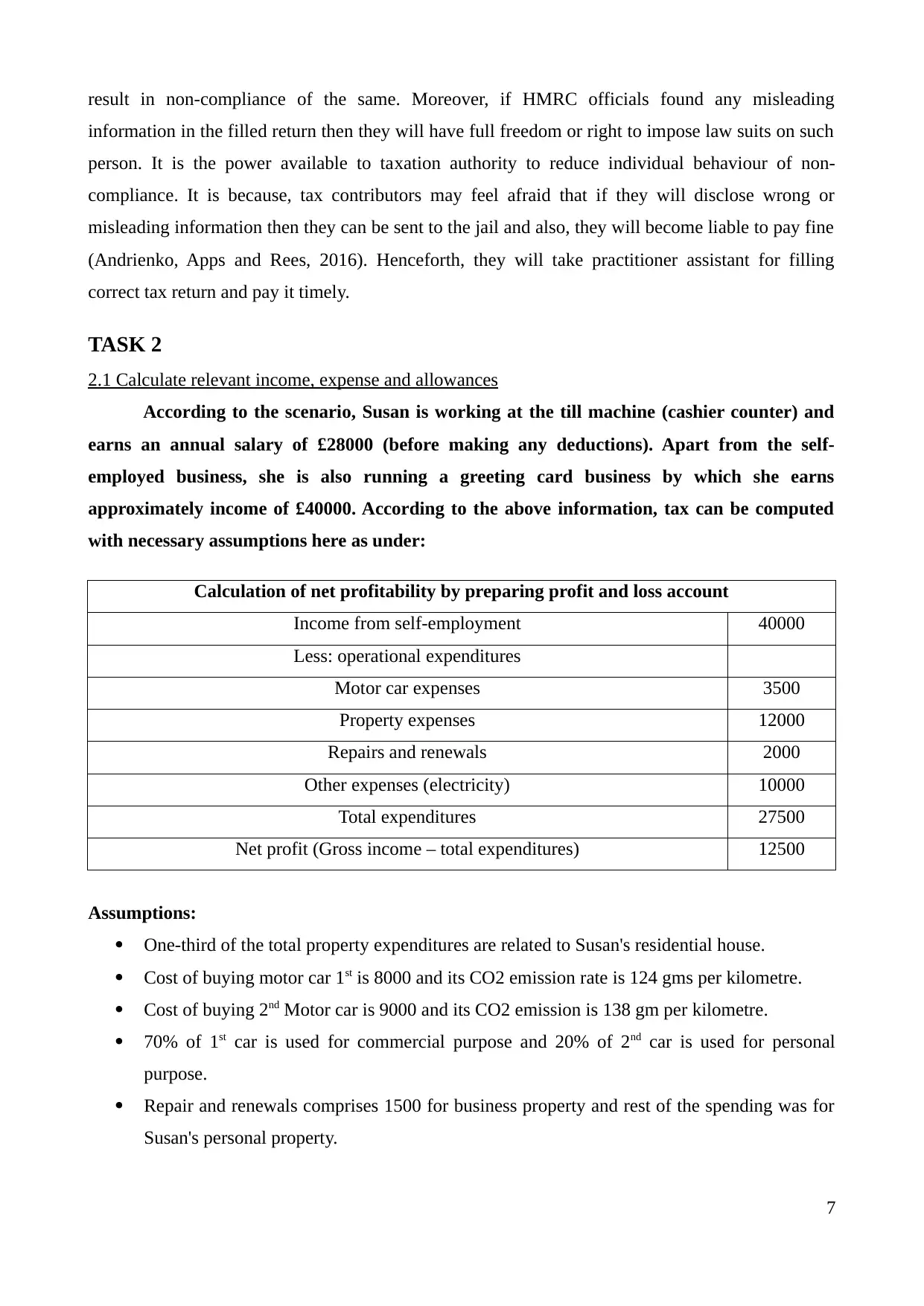
result in non-compliance of the same. Moreover, if HMRC officials found any misleading
information in the filled return then they will have full freedom or right to impose law suits on such
person. It is the power available to taxation authority to reduce individual behaviour of non-
compliance. It is because, tax contributors may feel afraid that if they will disclose wrong or
misleading information then they can be sent to the jail and also, they will become liable to pay fine
(Andrienko, Apps and Rees, 2016). Henceforth, they will take practitioner assistant for filling
correct tax return and pay it timely.
TASK 2
2.1 Calculate relevant income, expense and allowances
According to the scenario, Susan is working at the till machine (cashier counter) and
earns an annual salary of £28000 (before making any deductions). Apart from the self-
employed business, she is also running a greeting card business by which she earns
approximately income of £40000. According to the above information, tax can be computed
with necessary assumptions here as under:
Calculation of net profitability by preparing profit and loss account
Income from self-employment 40000
Less: operational expenditures
Motor car expenses 3500
Property expenses 12000
Repairs and renewals 2000
Other expenses (electricity) 10000
Total expenditures 27500
Net profit (Gross income – total expenditures) 12500
Assumptions:
One-third of the total property expenditures are related to Susan's residential house.
Cost of buying motor car 1st is 8000 and its CO2 emission rate is 124 gms per kilometre.
Cost of buying 2nd Motor car is 9000 and its CO2 emission is 138 gm per kilometre.
70% of 1st car is used for commercial purpose and 20% of 2nd car is used for personal
purpose.
Repair and renewals comprises 1500 for business property and rest of the spending was for
Susan's personal property.
7
information in the filled return then they will have full freedom or right to impose law suits on such
person. It is the power available to taxation authority to reduce individual behaviour of non-
compliance. It is because, tax contributors may feel afraid that if they will disclose wrong or
misleading information then they can be sent to the jail and also, they will become liable to pay fine
(Andrienko, Apps and Rees, 2016). Henceforth, they will take practitioner assistant for filling
correct tax return and pay it timely.
TASK 2
2.1 Calculate relevant income, expense and allowances
According to the scenario, Susan is working at the till machine (cashier counter) and
earns an annual salary of £28000 (before making any deductions). Apart from the self-
employed business, she is also running a greeting card business by which she earns
approximately income of £40000. According to the above information, tax can be computed
with necessary assumptions here as under:
Calculation of net profitability by preparing profit and loss account
Income from self-employment 40000
Less: operational expenditures
Motor car expenses 3500
Property expenses 12000
Repairs and renewals 2000
Other expenses (electricity) 10000
Total expenditures 27500
Net profit (Gross income – total expenditures) 12500
Assumptions:
One-third of the total property expenditures are related to Susan's residential house.
Cost of buying motor car 1st is 8000 and its CO2 emission rate is 124 gms per kilometre.
Cost of buying 2nd Motor car is 9000 and its CO2 emission is 138 gm per kilometre.
70% of 1st car is used for commercial purpose and 20% of 2nd car is used for personal
purpose.
Repair and renewals comprises 1500 for business property and rest of the spending was for
Susan's personal property.
7
Paraphrase This Document
Need a fresh take? Get an instant paraphrase of this document with our AI Paraphraser
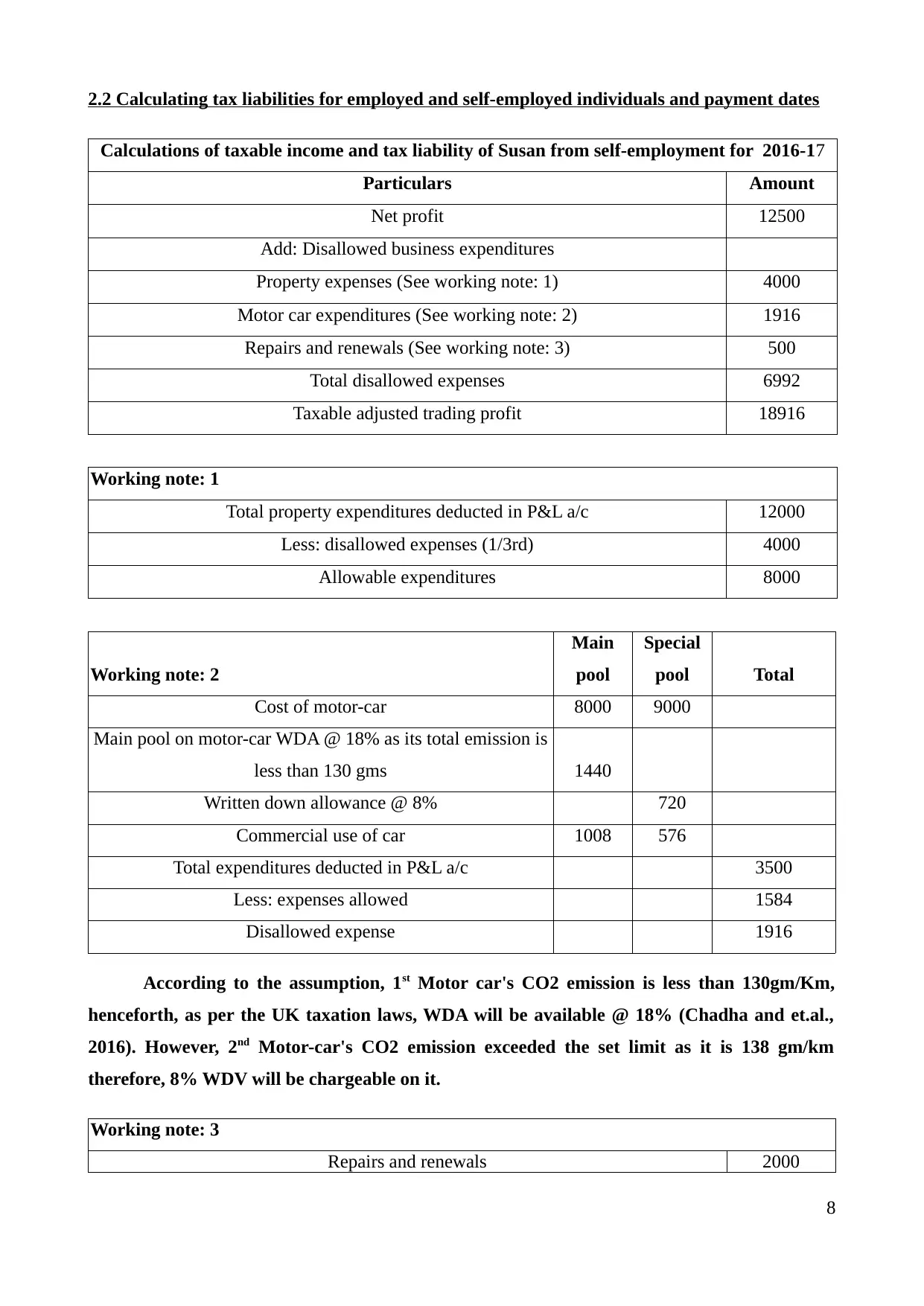
2.2 Calculating tax liabilities for employed and self-employed individuals and payment dates
Calculations of taxable income and tax liability of Susan from self-employment for 2016-17
Particulars Amount
Net profit 12500
Add: Disallowed business expenditures
Property expenses (See working note: 1) 4000
Motor car expenditures (See working note: 2) 1916
Repairs and renewals (See working note: 3) 500
Total disallowed expenses 6992
Taxable adjusted trading profit 18916
Working note: 1
Total property expenditures deducted in P&L a/c 12000
Less: disallowed expenses (1/3rd) 4000
Allowable expenditures 8000
Working note: 2
Main
pool
Special
pool Total
Cost of motor-car 8000 9000
Main pool on motor-car WDA @ 18% as its total emission is
less than 130 gms 1440
Written down allowance @ 8% 720
Commercial use of car 1008 576
Total expenditures deducted in P&L a/c 3500
Less: expenses allowed 1584
Disallowed expense 1916
According to the assumption, 1st Motor car's CO2 emission is less than 130gm/Km,
henceforth, as per the UK taxation laws, WDA will be available @ 18% (Chadha and et.al.,
2016). However, 2nd Motor-car's CO2 emission exceeded the set limit as it is 138 gm/km
therefore, 8% WDV will be chargeable on it.
Working note: 3
Repairs and renewals 2000
8
Calculations of taxable income and tax liability of Susan from self-employment for 2016-17
Particulars Amount
Net profit 12500
Add: Disallowed business expenditures
Property expenses (See working note: 1) 4000
Motor car expenditures (See working note: 2) 1916
Repairs and renewals (See working note: 3) 500
Total disallowed expenses 6992
Taxable adjusted trading profit 18916
Working note: 1
Total property expenditures deducted in P&L a/c 12000
Less: disallowed expenses (1/3rd) 4000
Allowable expenditures 8000
Working note: 2
Main
pool
Special
pool Total
Cost of motor-car 8000 9000
Main pool on motor-car WDA @ 18% as its total emission is
less than 130 gms 1440
Written down allowance @ 8% 720
Commercial use of car 1008 576
Total expenditures deducted in P&L a/c 3500
Less: expenses allowed 1584
Disallowed expense 1916
According to the assumption, 1st Motor car's CO2 emission is less than 130gm/Km,
henceforth, as per the UK taxation laws, WDA will be available @ 18% (Chadha and et.al.,
2016). However, 2nd Motor-car's CO2 emission exceeded the set limit as it is 138 gm/km
therefore, 8% WDV will be chargeable on it.
Working note: 3
Repairs and renewals 2000
8
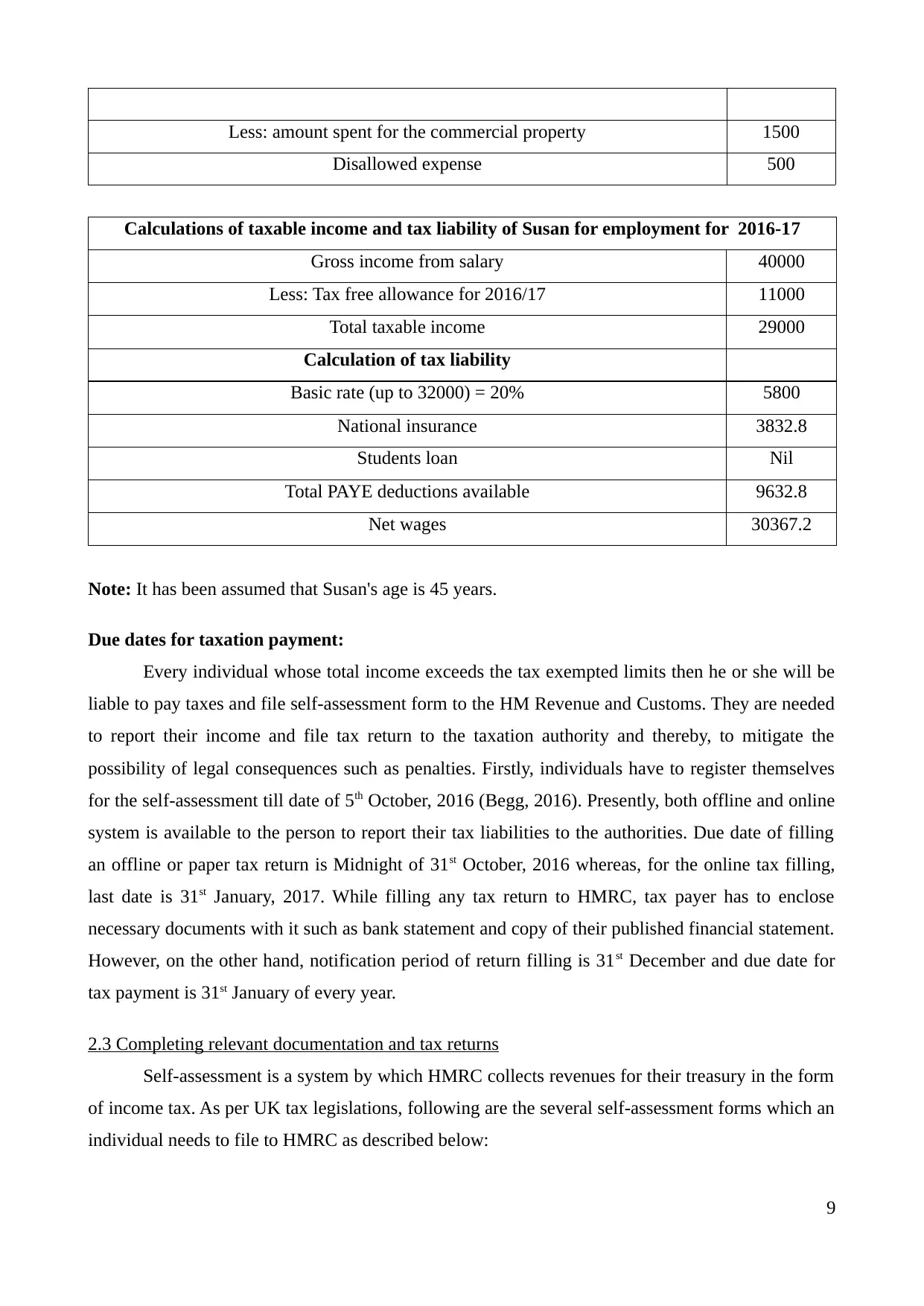
Less: amount spent for the commercial property 1500
Disallowed expense 500
Calculations of taxable income and tax liability of Susan for employment for 2016-17
Gross income from salary 40000
Less: Tax free allowance for 2016/17 11000
Total taxable income 29000
Calculation of tax liability
Basic rate (up to 32000) = 20% 5800
National insurance 3832.8
Students loan Nil
Total PAYE deductions available 9632.8
Net wages 30367.2
Note: It has been assumed that Susan's age is 45 years.
Due dates for taxation payment:
Every individual whose total income exceeds the tax exempted limits then he or she will be
liable to pay taxes and file self-assessment form to the HM Revenue and Customs. They are needed
to report their income and file tax return to the taxation authority and thereby, to mitigate the
possibility of legal consequences such as penalties. Firstly, individuals have to register themselves
for the self-assessment till date of 5th October, 2016 (Begg, 2016). Presently, both offline and online
system is available to the person to report their tax liabilities to the authorities. Due date of filling
an offline or paper tax return is Midnight of 31st October, 2016 whereas, for the online tax filling,
last date is 31st January, 2017. While filling any tax return to HMRC, tax payer has to enclose
necessary documents with it such as bank statement and copy of their published financial statement.
However, on the other hand, notification period of return filling is 31st December and due date for
tax payment is 31st January of every year.
2.3 Completing relevant documentation and tax returns
Self-assessment is a system by which HMRC collects revenues for their treasury in the form
of income tax. As per UK tax legislations, following are the several self-assessment forms which an
individual needs to file to HMRC as described below:
9
Disallowed expense 500
Calculations of taxable income and tax liability of Susan for employment for 2016-17
Gross income from salary 40000
Less: Tax free allowance for 2016/17 11000
Total taxable income 29000
Calculation of tax liability
Basic rate (up to 32000) = 20% 5800
National insurance 3832.8
Students loan Nil
Total PAYE deductions available 9632.8
Net wages 30367.2
Note: It has been assumed that Susan's age is 45 years.
Due dates for taxation payment:
Every individual whose total income exceeds the tax exempted limits then he or she will be
liable to pay taxes and file self-assessment form to the HM Revenue and Customs. They are needed
to report their income and file tax return to the taxation authority and thereby, to mitigate the
possibility of legal consequences such as penalties. Firstly, individuals have to register themselves
for the self-assessment till date of 5th October, 2016 (Begg, 2016). Presently, both offline and online
system is available to the person to report their tax liabilities to the authorities. Due date of filling
an offline or paper tax return is Midnight of 31st October, 2016 whereas, for the online tax filling,
last date is 31st January, 2017. While filling any tax return to HMRC, tax payer has to enclose
necessary documents with it such as bank statement and copy of their published financial statement.
However, on the other hand, notification period of return filling is 31st December and due date for
tax payment is 31st January of every year.
2.3 Completing relevant documentation and tax returns
Self-assessment is a system by which HMRC collects revenues for their treasury in the form
of income tax. As per UK tax legislations, following are the several self-assessment forms which an
individual needs to file to HMRC as described below:
9
⊘ This is a preview!⊘
Do you want full access?
Subscribe today to unlock all pages.

Trusted by 1+ million students worldwide
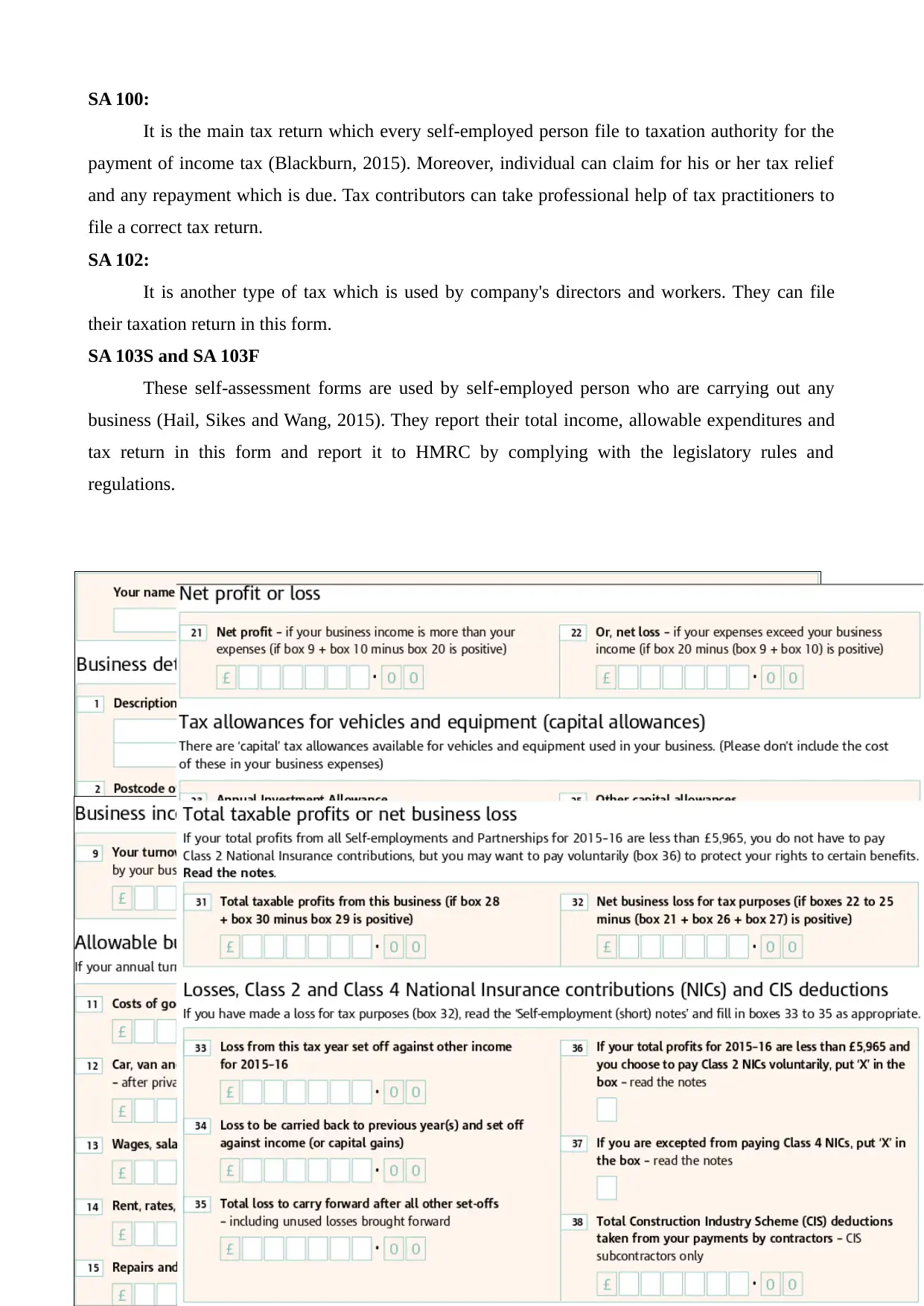
SA 100:
It is the main tax return which every self-employed person file to taxation authority for the
payment of income tax (Blackburn, 2015). Moreover, individual can claim for his or her tax relief
and any repayment which is due. Tax contributors can take professional help of tax practitioners to
file a correct tax return.
SA 102:
It is another type of tax which is used by company's directors and workers. They can file
their taxation return in this form.
SA 103S and SA 103F
These self-assessment forms are used by self-employed person who are carrying out any
business (Hail, Sikes and Wang, 2015). They report their total income, allowable expenditures and
tax return in this form and report it to HMRC by complying with the legislatory rules and
regulations.
10
It is the main tax return which every self-employed person file to taxation authority for the
payment of income tax (Blackburn, 2015). Moreover, individual can claim for his or her tax relief
and any repayment which is due. Tax contributors can take professional help of tax practitioners to
file a correct tax return.
SA 102:
It is another type of tax which is used by company's directors and workers. They can file
their taxation return in this form.
SA 103S and SA 103F
These self-assessment forms are used by self-employed person who are carrying out any
business (Hail, Sikes and Wang, 2015). They report their total income, allowable expenditures and
tax return in this form and report it to HMRC by complying with the legislatory rules and
regulations.
10
Paraphrase This Document
Need a fresh take? Get an instant paraphrase of this document with our AI Paraphraser
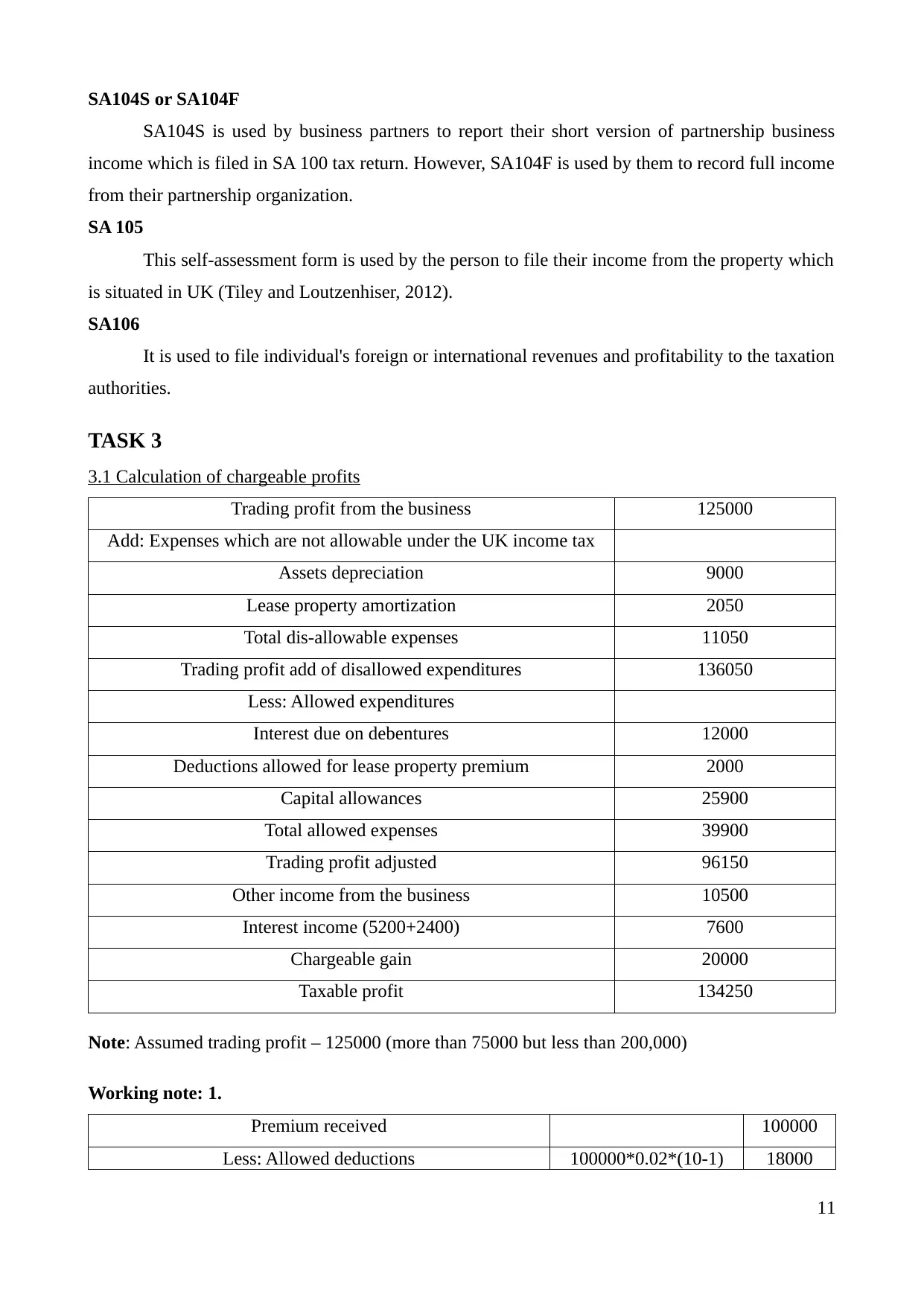
SA104S or SA104F
SA104S is used by business partners to report their short version of partnership business
income which is filed in SA 100 tax return. However, SA104F is used by them to record full income
from their partnership organization.
SA 105
This self-assessment form is used by the person to file their income from the property which
is situated in UK (Tiley and Loutzenhiser, 2012).
SA106
It is used to file individual's foreign or international revenues and profitability to the taxation
authorities.
TASK 3
3.1 Calculation of chargeable profits
Trading profit from the business 125000
Add: Expenses which are not allowable under the UK income tax
Assets depreciation 9000
Lease property amortization 2050
Total dis-allowable expenses 11050
Trading profit add of disallowed expenditures 136050
Less: Allowed expenditures
Interest due on debentures 12000
Deductions allowed for lease property premium 2000
Capital allowances 25900
Total allowed expenses 39900
Trading profit adjusted 96150
Other income from the business 10500
Interest income (5200+2400) 7600
Chargeable gain 20000
Taxable profit 134250
Note: Assumed trading profit – 125000 (more than 75000 but less than 200,000)
Working note: 1.
Premium received 100000
Less: Allowed deductions 100000*0.02*(10-1) 18000
11
SA104S is used by business partners to report their short version of partnership business
income which is filed in SA 100 tax return. However, SA104F is used by them to record full income
from their partnership organization.
SA 105
This self-assessment form is used by the person to file their income from the property which
is situated in UK (Tiley and Loutzenhiser, 2012).
SA106
It is used to file individual's foreign or international revenues and profitability to the taxation
authorities.
TASK 3
3.1 Calculation of chargeable profits
Trading profit from the business 125000
Add: Expenses which are not allowable under the UK income tax
Assets depreciation 9000
Lease property amortization 2050
Total dis-allowable expenses 11050
Trading profit add of disallowed expenditures 136050
Less: Allowed expenditures
Interest due on debentures 12000
Deductions allowed for lease property premium 2000
Capital allowances 25900
Total allowed expenses 39900
Trading profit adjusted 96150
Other income from the business 10500
Interest income (5200+2400) 7600
Chargeable gain 20000
Taxable profit 134250
Note: Assumed trading profit – 125000 (more than 75000 but less than 200,000)
Working note: 1.
Premium received 100000
Less: Allowed deductions 100000*0.02*(10-1) 18000
11
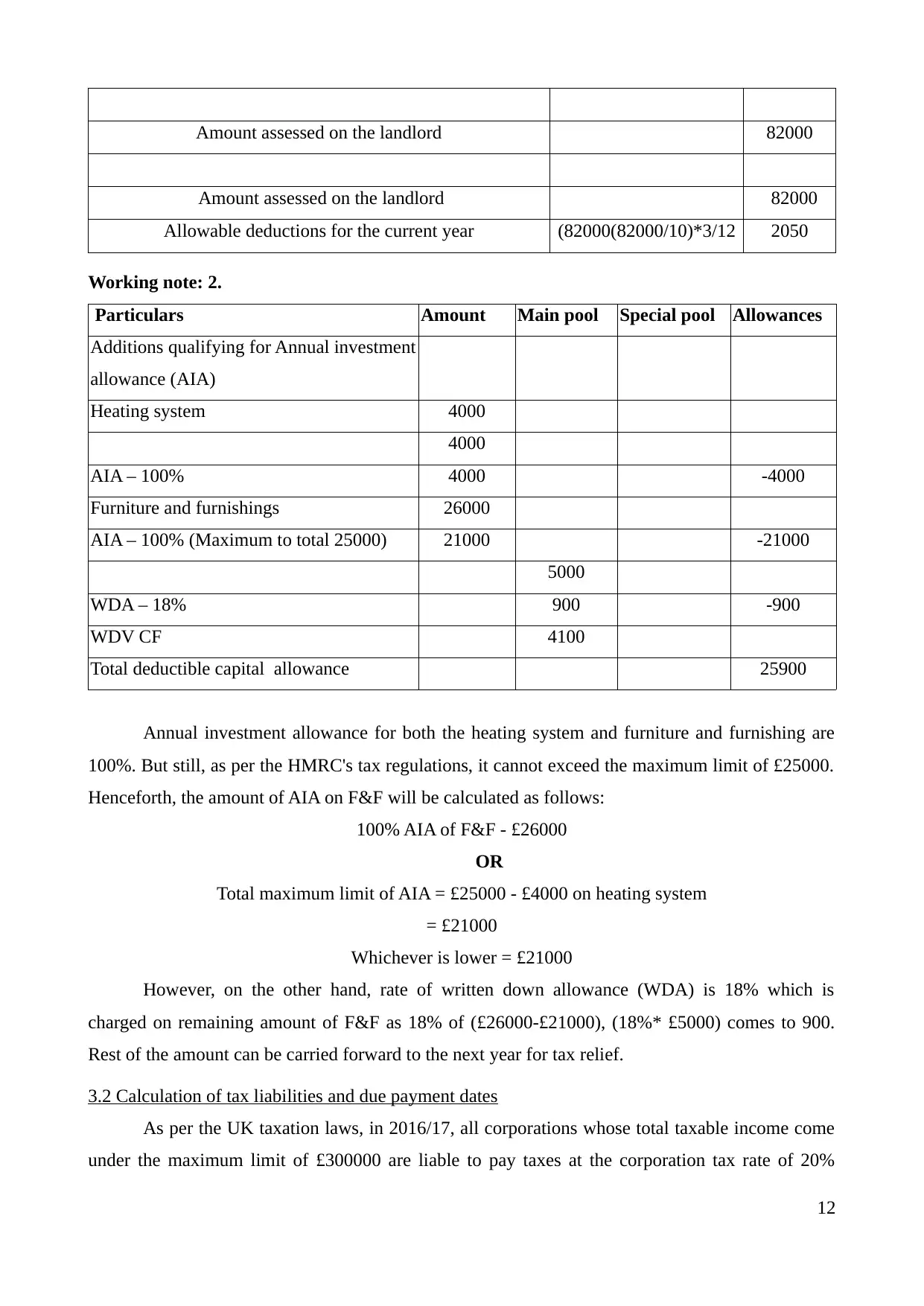
Amount assessed on the landlord 82000
Amount assessed on the landlord 82000
Allowable deductions for the current year (82000(82000/10)*3/12 2050
Working note: 2.
Particulars Amount Main pool Special pool Allowances
Additions qualifying for Annual investment
allowance (AIA)
Heating system 4000
4000
AIA – 100% 4000 -4000
Furniture and furnishings 26000
AIA – 100% (Maximum to total 25000) 21000 -21000
5000
WDA – 18% 900 -900
WDV CF 4100
Total deductible capital allowance 25900
Annual investment allowance for both the heating system and furniture and furnishing are
100%. But still, as per the HMRC's tax regulations, it cannot exceed the maximum limit of £25000.
Henceforth, the amount of AIA on F&F will be calculated as follows:
100% AIA of F&F - £26000
OR
Total maximum limit of AIA = £25000 - £4000 on heating system
= £21000
Whichever is lower = £21000
However, on the other hand, rate of written down allowance (WDA) is 18% which is
charged on remaining amount of F&F as 18% of (£26000-£21000), (18%* £5000) comes to 900.
Rest of the amount can be carried forward to the next year for tax relief.
3.2 Calculation of tax liabilities and due payment dates
As per the UK taxation laws, in 2016/17, all corporations whose total taxable income come
under the maximum limit of £300000 are liable to pay taxes at the corporation tax rate of 20%
12
Amount assessed on the landlord 82000
Allowable deductions for the current year (82000(82000/10)*3/12 2050
Working note: 2.
Particulars Amount Main pool Special pool Allowances
Additions qualifying for Annual investment
allowance (AIA)
Heating system 4000
4000
AIA – 100% 4000 -4000
Furniture and furnishings 26000
AIA – 100% (Maximum to total 25000) 21000 -21000
5000
WDA – 18% 900 -900
WDV CF 4100
Total deductible capital allowance 25900
Annual investment allowance for both the heating system and furniture and furnishing are
100%. But still, as per the HMRC's tax regulations, it cannot exceed the maximum limit of £25000.
Henceforth, the amount of AIA on F&F will be calculated as follows:
100% AIA of F&F - £26000
OR
Total maximum limit of AIA = £25000 - £4000 on heating system
= £21000
Whichever is lower = £21000
However, on the other hand, rate of written down allowance (WDA) is 18% which is
charged on remaining amount of F&F as 18% of (£26000-£21000), (18%* £5000) comes to 900.
Rest of the amount can be carried forward to the next year for tax relief.
3.2 Calculation of tax liabilities and due payment dates
As per the UK taxation laws, in 2016/17, all corporations whose total taxable income come
under the maximum limit of £300000 are liable to pay taxes at the corporation tax rate of 20%
12
⊘ This is a preview!⊘
Do you want full access?
Subscribe today to unlock all pages.

Trusted by 1+ million students worldwide
1 out of 17
Related Documents
Your All-in-One AI-Powered Toolkit for Academic Success.
+13062052269
info@desklib.com
Available 24*7 on WhatsApp / Email
![[object Object]](/_next/static/media/star-bottom.7253800d.svg)
Unlock your academic potential
Copyright © 2020–2025 A2Z Services. All Rights Reserved. Developed and managed by ZUCOL.





